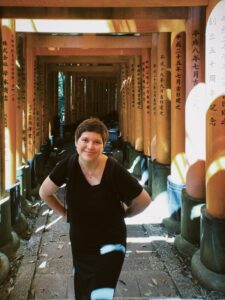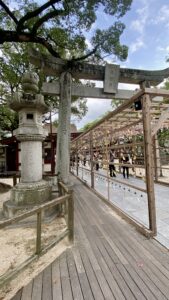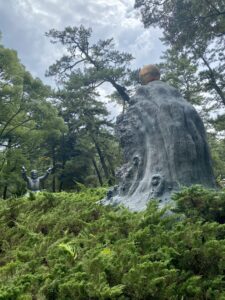Paz Daniela Ortiz Santa Maria ’26 Investigates Similarities in Japanese Shinto and Peruvian Indigenous Belief Systems
Paz Daniela Ortiz Santa Maria ’26 conducted research last summer supported by the Tanaka Fund at CUGS across Japan in search of an understanding of similarities between Japanese Shinto and Peruvian indigenous belief systems from the Inca period.
Paz came to Trinity after attending high school in Cusco, Peru, and beginning her postsecondary education at United World College Red Cross Nordic (UWC RCN) and St. John’s College. The seed of an idea for her Tanaka project came in an IB Philosophy class at UWC where she learned about John Hick’s theory of religious pluralism – a theory that all religions in the world are interconnected.

“Since the class was composed of people from all over the world, it was really interesting to talk about those kinds of theories with peers who have different creeds and views of religion and the practice of faith,” remembers Paz.
In her first semester at Trinity, Paz took a Japanese Studies class with Professor K. Izumi. As they were studying Japanese literature and film, she noticed the philosophical foundations of stories in Japanese culture were very similar to the philosophical foundations of the Peruvian indigenous beliefs she grew up around.
“I did some research and noticed there wasn’t a lot of literature to compare the belief systems,” explains Paz. Remembering the theory of religious pluralism from her UWC class, she put together a proposal for a CUGS summer research project supported by the Tanaka Fund.
After researching the Japanese prefectures with the largest Shinto influence, Paz planned a 3-week trip to visit five prefectures – Tokyo, Kyoto, Mie, Shimane, and Fukuoka.
“I would get up really early to figure out how to get to the temple or shrine I was planning to visit that day. I went to a couple of museums as well, but I prioritized temples and shrines or places of religious significance,” Paz describes.
She visited two or three sites per day and would stay at each site for three to four hours.
To prepare for the research trip, Paz and her advisor Prof. Gabriel Salgado read a book on how to take ethnographic field notes. Paz incorporated drawings into her field notes as part of her research emphasis on the aesthetic similarities of the belief systems.
In addition to aesthetic similarities, Paz found the nature-based architecture of Shinto was similar to architecture in her hometown. She notes that the most significant philosophical similarity she noticed was the way the concept of time had similarities between the two very distanced cultures.

Paz’s research was not conclusive on what may explain the similarities between the belief systems, but she presents a hypothesis that the cosmologies may have similarities because of geographical determinism.
“Geographical determinism is the idea that a society that is so heavily influenced by the geographical phenomena around them will have their ideology, philosophy, art, and religion affected by their geography,” Paz says, “The Shinto areas have very similar geographical diversity to a civilization like the Incas.”
Paz collected an impressive amount of field notes, observations, and hypotheses last summer, but she feels like this is just the beginning of this line of inquiry.
“I think there is a lot more to talk about and dig into. I would love to have this as a senior thesis project. Either way, this really feels like a passion project,” she says.
Fueling her passion is her feeling that greater understanding and repair can come for Peruvians by understanding what their religious sites might look like if not for colonization.

“There was a moment in Mie at a grand shrine where I saw very old pictures showing how the shrine had always been well taken care of. It got me thinking about how our religious sites would look if we had always had the chance to take care of them ourselves,” Paz reflects. “It was a moment of realization that this kind of investigation can help reveal things about colonized nations by way of comparing and extrapolation.”
Paz’s project has already traveled across continents from a seed of an idea in Norway to a concrete proposal at Trinity College to a field study in Japan and pages of beautiful ethnographic field notes making their way to her home in Peru. We are excited to see where her passion takes the project next.
Cover photo: Matsunoo Taisha shrine in Kyoto. Photo by Paz Daniela Ortiz Santa Maria.
